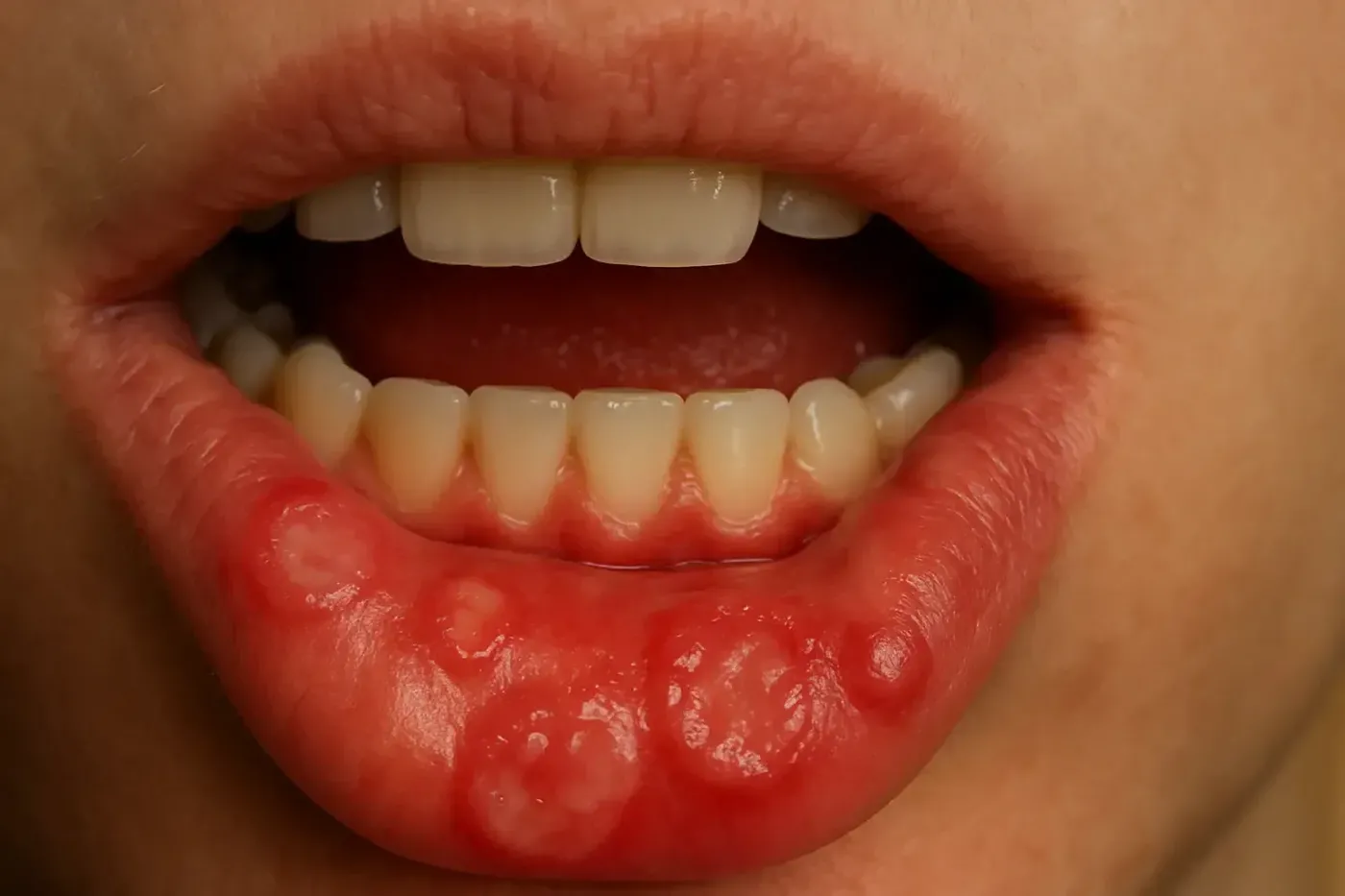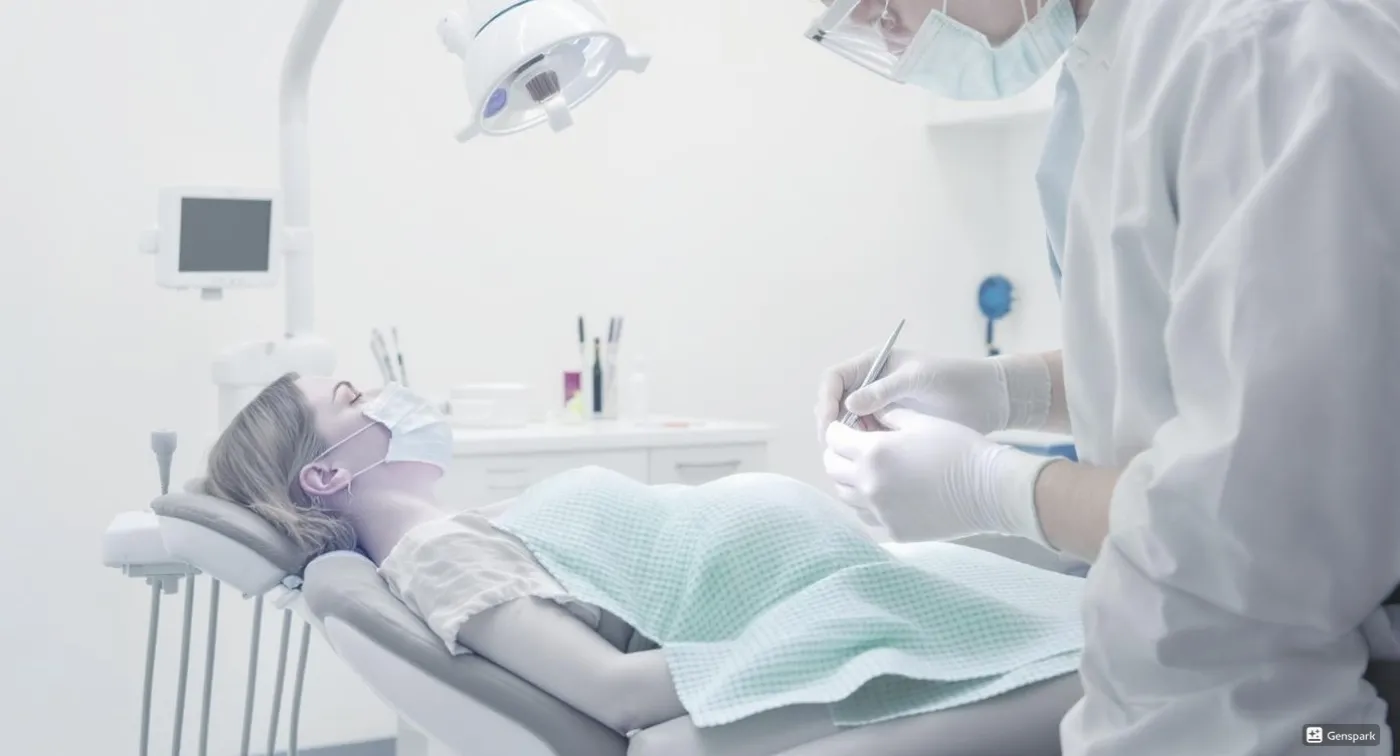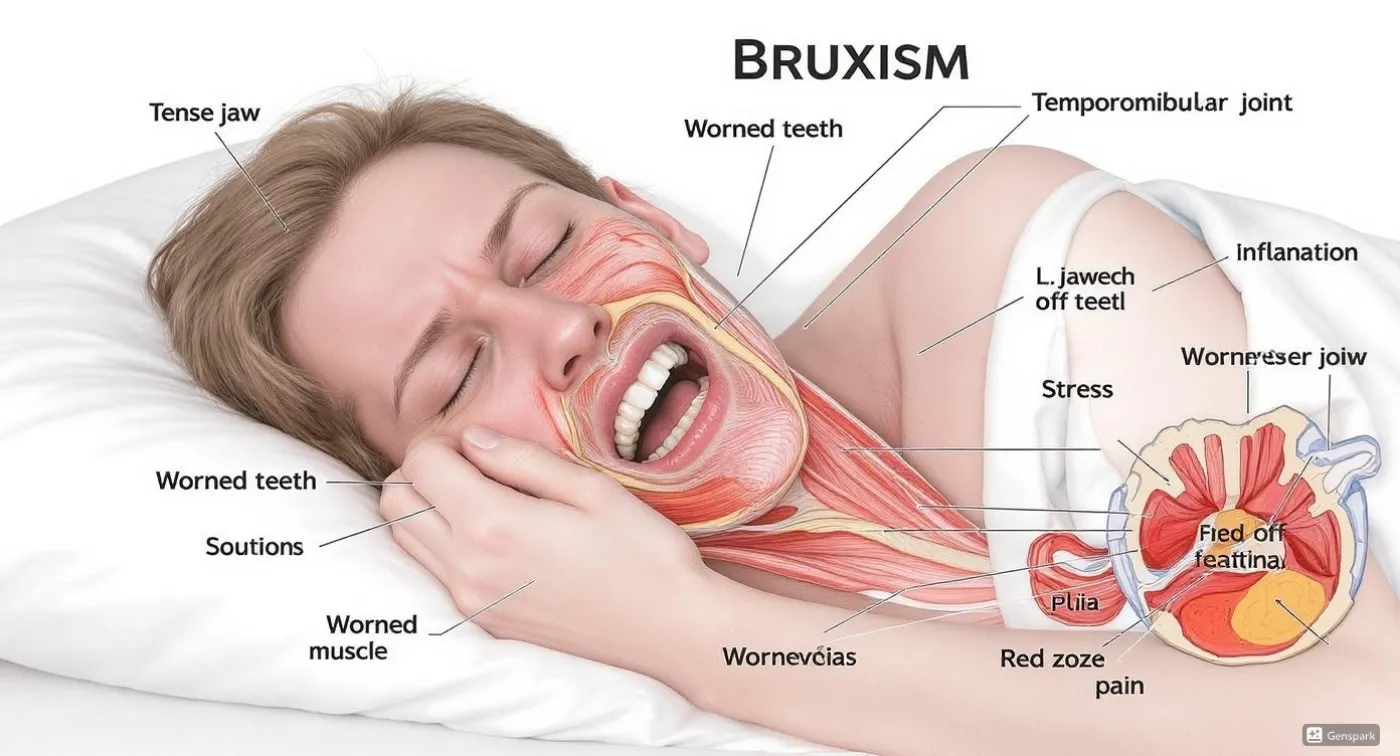Stomatitis is inflammation of the oral mucosa with ulcers and pain caused by injuries, infections, or allergies. Treatment: antiseptics and anti-inflammatory agents. Prevention: good hygiene, strengthening the immune system, and regular dental visits.

Stomatitis: What Is It? Causes, Symptoms, and Treatment
Stomatitis on the tongue, gums, lips, and inner cheeks is an inflammatory process affecting the mucous membrane of the oral cavity. Its main signs include redness, swelling, and the appearance of painful ulcers or sores on the inner surfaces of the lips, cheeks, tongue, gums, or palate. This condition can occur as a standalone disease or as a symptom of other pathologies. The term “stomatitis” comes from the Greek word “stoma,” meaning mouth, and the suffix “-itis,” indicating inflammation. The disease can significantly worsen quality of life, complicating eating and speaking, and thus requires careful diagnosis and comprehensive treatment.
In this article, we will take a closer look at the course of stomatitis, its symptoms, and modern treatment methods to provide a complete understanding of the problem and ways to overcome it.
Causes of Stomatitis on the Gums and Tongue
This symptom can develop for various reasons, each triggering an inflammatory process in the oral cavity. It is important to understand that factors may act independently or simultaneously, exacerbating the disease.
Main causes of stomatitis in the mouth:
- Traumatic injuries. Mechanical damage to the oral mucosa (such as accidentally biting the cheek, irritation from dental prostheses, injury from hard food or a toothbrush) can cause localised inflammation.
- Infectious factors. Bacteria, fungi, and viruses — including herpes, Epstein-Barr virus, and Candida albicans — often cause stomatitis by provoking different forms of the disease.
- Allergic reactions. Increased sensitivity to certain foods, medications, or components of oral hygiene products can trigger mucosal inflammation as a reaction to allergens.
- Vitamin and mineral deficiencies. Lack of important nutrients such as vitamin B12, folic acid, iron, and zinc negatively affects tissue healing and increases susceptibility to stomatitis.
- Systemic diseases. Disorders of the gastrointestinal tract (e.g., Crohn’s disease, celiac disease), endocrine disorders, diabetes, and immune deficiency states can underlie the development of oral inflammation.
- Stress and fatigue. Emotional stress, chronic fatigue, and sleep disturbances weaken the immune system, potentially triggering stomatitis.
- Side effects of medications. Certain drugs, including antibiotics, chemotherapy agents, or anticonvulsants, may irritate the oral mucosa and promote inflammation.
- Harmful habits. Smoking and alcohol consumption adversely affect the protective properties of the mucous membrane, creating favorable conditions for stomatitis.
- Hormonal fluctuations. Changes in hormone levels during pregnancy, menstrual cycles, or menopause can affect the condition of the oral mucosa and cause inflammation.
Understanding these factors helps prevent stomatitis and choose the most effective treatment strategy.
Types of Stomatitis
Bacterial stomatitis
Occurs due to the activity of streptococci or staphylococci. Its main sign is redness of the oral mucosa. In the case of the necrotic form, purulent eruptions may appear.
Viral (herpetic) stomatitis
This form develops as a result of infection with herpes virus type 1 or 2. Symptoms usually appear almost immediately after the virus enters the body. This type is characterised by the formation of blisters on the mucous membrane, which burst after a few days. In severe cases, a widespread rash may be observed on the tongue, under the tongue, lips, cheeks, and palate, accompanied by a high fever. The main factors contributing to the development of viral stomatitis are weakened immunity, as well as the presence of dental plaque and soft deposits.
Fungal (candidal) stomatitis
This type of disease is caused by fungi of the Candida genus. Stomatitis manifests as a white coating on the tongue and inner cheeks, as well as redness of the mucous membranes of the lips and tongue. Additional symptoms may include characteristic lesions of the gums and tongue. Factors promoting infection include contact with contaminated objects, consumption of infected food, prolonged use of antibiotics, metabolic disorders, dysbiosis, and direct contact with an infected person.
Radiation stomatitis
Develops as a consequence of radiation sickness or as a complication after chemotherapy. The main symptoms include the appearance of erosions in the oral cavity and thickening of certain areas of the mucous membrane.
Traumatic stomatitis
Occurs due to mechanical, thermal, or chemical injury and manifests as painful ulcers at the injury sites.
Allergic stomatitis
Develops as a reaction of the body to allergens, which may include medications, hygiene products, dental materials, and dental prostheses.
Why Stomatitis Is Dangerous for Children and Adults
Timely diagnosis and treatment can make the course of the disease relatively safe. However, in practice, adult patients often delay seeking professional help due to subjective reasons. As a result, the disease may become complicated, develop into a chronic condition, and turn into a recurrent form accompanied by frequent exacerbations.
Main Forms of the Disease
Catarrhal stomatitis – the mildest form of the disease, which responds relatively easily and quickly to treatment. Its main signs include:
- the appearance of isolated grayish spots;
- increased salivation;
- swelling of the mucous membrane.
However, without proper therapy, catarrhal stomatitis can worsen within a few weeks: swelling of the tongue appears, a brown coating forms, and the disease may progress to an ulcerative form.
Complicated ulcerative stomatitis is characterised by the spread of ulcers throughout the oral cavity, significant swelling, bleeding gums, a body temperature increase up to 37.5 °C, and pain in the gum area. If effective medical intervention is not received at this stage (for example, if the patient tries to self-treat with natural remedies), large ulcers up to 6 cm in diameter may form on the cheeks. These lesions are accompanied by deep tissue necrosis, high fever, and an increased risk of the disease becoming recurrent.
Aphthous stomatitis is one of the most common forms of the disease. It is accompanied by the appearance of round painful erosions with a pronounced red border. If treatment is delayed or insufficient, the disease can become chronic, which is much more difficult to treat.
Symptoms of Stomatitis
The symptoms can vary significantly in intensity and nature depending on the cause and form of the disease. Recognizing the typical clinical signs allows for timely detection of the condition and the start of appropriate treatment:
- Pain and discomfort. Pain is one of the main symptoms of stomatitis, usually worsening during eating, drinking, or talking. Discomfort may manifest as mild burning or escalate into sharp, severe pain.
- Redness and swelling of the mucous membrane. Inflamed areas in the oral cavity become red and swollen, indicating a localised inflammatory reaction.
- Formation of ulcers and sores. Small painful sores appear on the mucous membrane of the cheeks, lips, gums, or tongue, often surrounded by a red border. These can be single or multiple.
- Coating on the tongue surface and mucosa. Certain forms of stomatitis cause the appearance of white or yellowish coating, indicating the presence of an infectious agent.
- Burning and tingling sensations. These symptoms often precede the appearance of ulcers and indicate the onset of inflammation.
- Gum bleeding. This is especially noticeable during tooth brushing or chewing.
- Enlarged and tender lymph nodes. In severe cases of stomatitis, lymph nodes under the jaw or in the neck may enlarge and become painful when pressed.
- Unpleasant mouth odor. The inflammatory process and mucosal lesions often cause bad breath or halitosis.
- Increased body temperature. In acute cases, the temperature may rise to subfebrile or even febrile levels.
- General weakness and malaise. Patients may experience fatigue, lethargy, and loss of appetite due to pain and overall discomfort.
Additional symptoms may include increased tooth sensitivity, sleep disturbances, and changes in taste perception, all negatively affecting the patient's quality of life.
Diagnosis of Stomatitis
In most cases, to make an accurate diagnosis, a dentist only needs to take the patient’s medical history and conduct a clinical examination. However, in some situations, laboratory tests or consultations with specialists from other fields may be necessary to determine the exact treatment strategy.
Only after identifying the type of pathogen can the doctor decide on the appropriate treatment for stomatitis in each specific case and select the proper therapy. High-quality services are provided by the specialists at Gallant Dental Clinic.
How to Treat Stomatitis
If stomatitis is left untreated or treated incorrectly, it can develop into a complicated or chronic form with relapses.
That is why therapy for both adults and children must be comprehensive. A modern approach to treating stomatitis includes several main components:
- Eliminating symptoms and eradicating the pathogen in the oral cavity.
- Identifying and eliminating factors that contribute to the development of inflammation.
- Boosting immunity and strengthening the body's overall defense capacity.
- Conducting preventive measures to avoid recurrence of the disease.
Always consult a doctor at the first signs of a problem. Self-treatment or using natural remedies often leads to complications. Only a qualified specialist can accurately diagnose and prescribe an effective treatment plan, taking into account the individual characteristics of each patient.
Treatment for Stomatitis
Comprehensive treatment involves both general and local therapy using appropriately selected medications. The choice of drugs depends on the form of the disease and the severity of its course.
For example, in aphthous stomatitis, it is necessary to regularly treat the affected areas with antiseptic and healing agents, rinse the mouth with special solutions, and use gels with anti-inflammatory effects. If the disease has a bacterial origin, local antibiotics in the form of ointments and rinses are prescribed.
In cases of viral or candidal stomatitis, local antifungal medications are used in combination with anti-inflammatory agents. For allergic forms of mucositis, antihistamines are added to the treatment regimen.
Regardless of the form of the disease, immunostimulants are always prescribed to help the body actively fight infection and inflammation.
Only an experienced dentist, after examination and laboratory testing (if necessary), can answer questions about how to treat stomatitis in adults or children, which method will be most effective, and how long the treatment will last.
Preventive Measures
Stomatitis can be prevented by following several simple but effective rules. These measures help reduce the risk of developing the disease:
- Systematic care of the oral cavity and teeth;
- Proper use and thorough disinfection of dental prostheses;
- Maintaining daily oral hygiene;
- Rinsing the mouth after taking antibiotics in syrup form;
- Timely treatment of infections, as well as gastrointestinal and cardiovascular diseases;
- Regular preventive visits to the dentist.
Additionally, it is extremely important to maintain the immune system at an adequate level.
Request a call
We will contact you to schedule a convenient time for your consultation and connect you with the right specialist
More articles
We have gathered all the most interesting posts from our specialist doctors in our blog just for you
Dental Treatment During Pregnancy: Myths and Facts

Bruxism (Teeth Grinding) and How to Get Rid of It Forever


Request a call
We’ll get back to you shortly!

Leave a Review
Your feedback means a lot to us!




